Situated among the Mid-Atlantic states, Virginia is bordered to the north by Maryland, to the west by Kentucky and West Virginia, to the south by North Carolina and Tennessee, and the east by Delaware, the Chesapeake Bay, and the Atlantic Ocean. If you’re planning a trip to the eastern side of the state, you may be wondering if you can visit Virginia’s lowest point.
In this guide, we’ll describe where the lowest point in Virginia occurs and how you can visit. Read on to learn more.
The Lowest Point in Virginia
The lowest point in Virginia occurs where the coast meets the Chesapeake Bay and the Atlantic Ocean. At these points, the elevation is 0 feet above sea level. Virginia is quite dynamic with coastal plains, a hilly interior, and the stunning Appalachian range running along the western side of the state. The mean elevation of Virginia is about 950 feet above sea level. The summit of Mount Rogers, at 5,520 feet in elevation, claims the spot as the highest point in Virginia. With over 7,000 miles of coastline along the Chesapeake Bay and Atlantic Ocean, tourists have ample opportunity to visit gorgeous areas at sea level.
The Lowest Point in Virginia: the Coastal Zone
The Coastal Zone of Virginia encompasses thousands of miles of shoreline. It includes the shorelines of the Chesapeake Bay, its tributaries, and the Atlantic Ocean. The area includes 100 inland miles of four tidal rivers- the Potomac, Rappahannock, York, and James Rivers. This zone includes Virginia’s Barrier Islands and encompasses 29% of Virginia’s land.
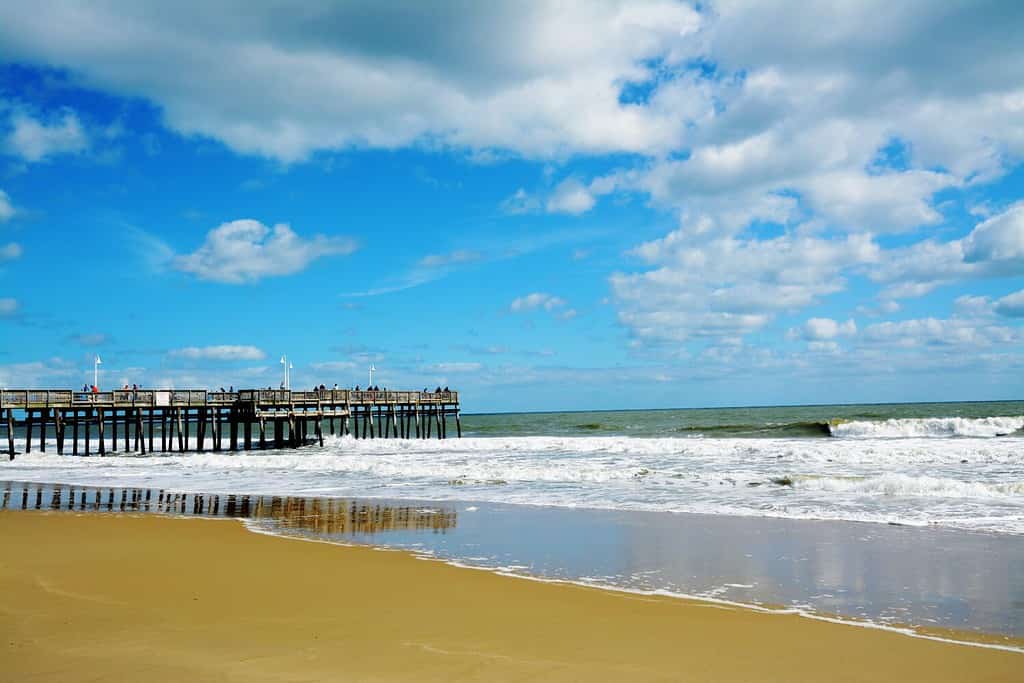
The lowest point in Virginia occurs along the coast of the Atlantic Ocean and Chesapeake Bay, part of Virginia’s spectacular Coastal Zone.
©Alexandr Junek Imaging/Shutterstock.com
Formation of the Atlantic Ocean
About 150 million years ago, a massive rift within the supercontinent, Pangaea, led to its breakup. This breakup of the supercontinent led to the formation of the Atlantic Ocean. Today, the Atlantic covers about one-fifth of the Earth’s surface and is the second-largest of the world’s five oceans. Virginia features 132 miles of shoreline along the Atlantic Ocean.
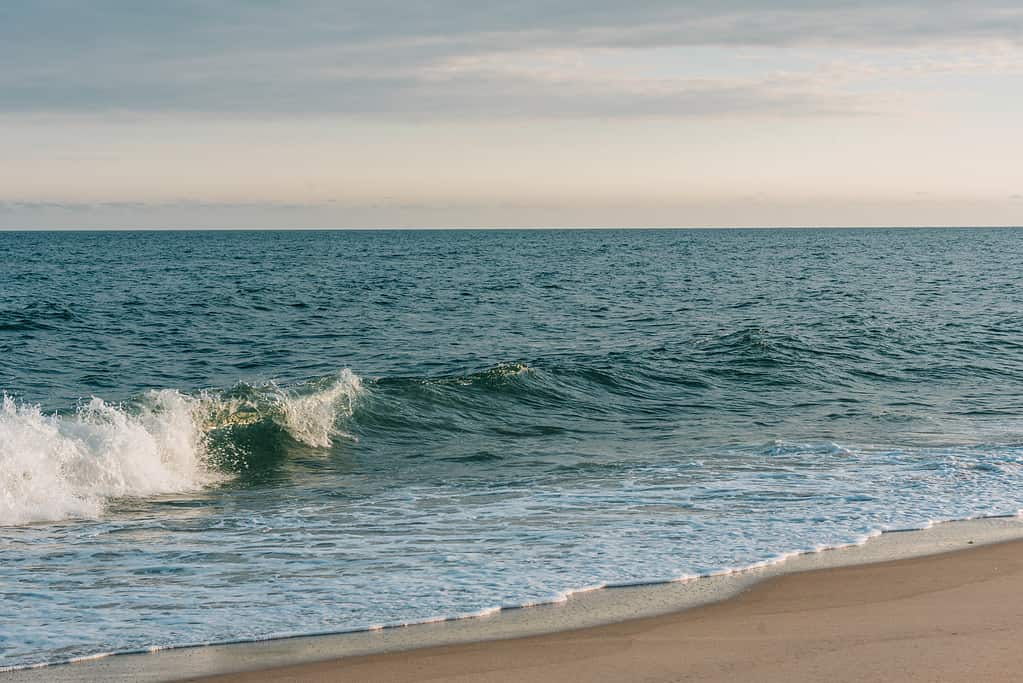
132 miles of Virginia’s coastline is bordered by the Atlantic Ocean.
©Jon Bilous/Shutterstock.com
The Formation of the Chesapeake Bay
About 10,000 years ago, melting glaciers flooded the Susquehanna River Valley. This event created the estuary environment of the Chesapeake Bay that we know today, as significant amounts of freshwater from land drainage mix with seawater within the Bay.
Lowest Point in Virginia: Ecology of Virginia’s Coastal Zone
Virginia’s Coastal Zone is characterized by marshes, estuarine beaches, oyster and intertidal reefs, rivers, aquatic vegetation, oceanic beaches, dunes, and mud and sand flats. Marine, freshwater, and estuarine wildlife flourish in this zone.
The Chesapeake Bay supports over 3,600 species of plant and animal life. About 350 species of fish live in or migrate through the Bay. Marine reptiles, including four species of sea turtles pass through the Chesapeake’s lower reaches. Marine mammals such as humpback and fin whales, and bottlenose dolphins make the Chesapeake their home at various points of the year. Over 140 species of shorebirds, seabirds, waterfowl, marsh birds, and raptors depend upon the Bay’s rich aquatic ecosystem. At least 12 species of sharks pass through the Chesapeake as well. Bull, sand tiger, and sandbar sharks are quite common in the area.
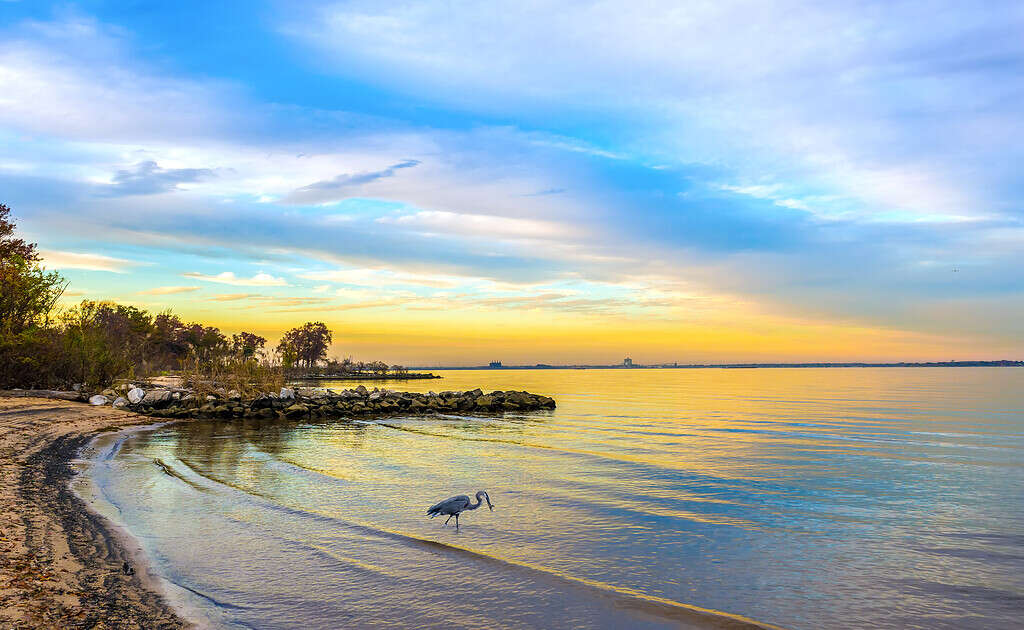
The Chesapeake Bay makes up a significant portion of Virginia’s Coastal Zone.
©iStock.com/flownaksala
Visiting the Lowest Point in Virginia
Amazing beaches and wildlife refuges occur in Virginia’s Coastal Zone. Below, we’ll delve into some of these beautiful areas that you can explore when visiting the lowest point in Virginia.
Dameron Marsh Natural Area Preserve
If you’re interested in visiting a stunning wildlife preserve at sea level, then head over to the Dameron Marsh Natural Area Preserve on the northeastern coast of Virginia. This 316-acre preserve is located on the shore of the Chesapeake Bay. According to the Virginia Department of Conservation and Recreation, it is one of the most significant wetlands on the Chesapeake Bay for populations of marsh birds.
This incredible wildlife area is accessible via a small public parking lot. So, arrive early to ensure you’ll have room to park. Year-round hours are from sunrise to sunset. Walking trails, a boardwalk, and a wildlife viewing platform allow visitors stunning overlooks of the marsh and Chesapeake Bay. Additionally, you can carry kayaks, canoes, and other small vessels for recreation in the Bay.
In addition to providing one of the most important habitats for Chesapeake Bay’s marsh birds, the preserve is also home to the federally threatened northeastern beach tiger beetle (Cicindela dorsalis dorsalis).
If you enjoy bird-watching, this is a must-visit location. In this magical wetland, can view marsh hawks (Circus cyaneus), great blue herons (Ardea herodias), brown pelicans (Pelecanus occidentalis), snowy egrets (Egretta thula), and horned grebes (Podiceps auritus).
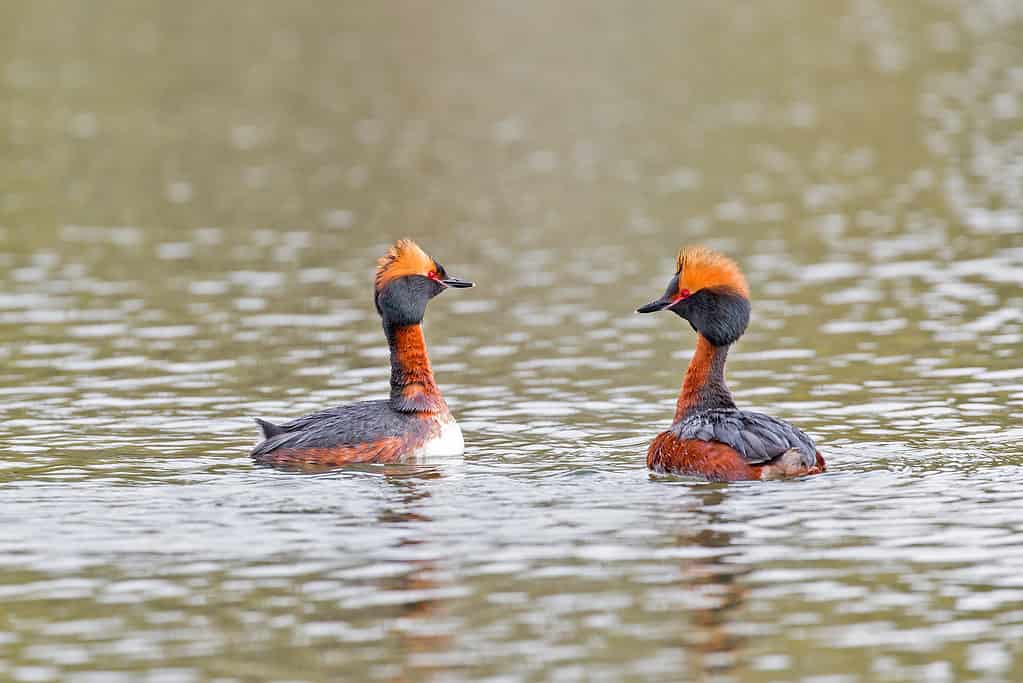
The horned grebe is a uniquely beautiful waterbird found in the Dameron Marsh Natural Area Preserve.
©Ihor Hvozdetskyi/Shutterstock.com
The Lowest Point in Virginia: Bethel Beach Natural Area Preserve
Located near the town of Onemo, Virginia, Bethel Beach Natural Area Preserve is located on the coast of Chesapeake Bay. This 105-acre preserve features a sandy shoreline, low dunes, and salt marsh habitats. This beach is popular with swimmers, joggers, shell hunters, and bird watchers. The strong Chesapeake Bay currents seasonally change the landscape of the preserve. At various times of the year, you may find tiny islets, shallow channels, and maritime landforms appearing and disappearing with the movements of the current.
In addition to providing a home and stopping point for year-round and migratory marsh and shorebirds, the beach is also home to the globally rare sea-beach knotweed (Polygonum glaucum).
The preserve is open to visitors from sunrise to sunset. There are no facilities on this site and parking is a small gravel lot, so make sure to plan accordingly. Some folks like to plan this secluded beach visit in conjunction with another location that has more amenities. Haven Beach is located 7 miles north of this preserve. This beach offers a larger parker area, restrooms, and designated swimming areas.
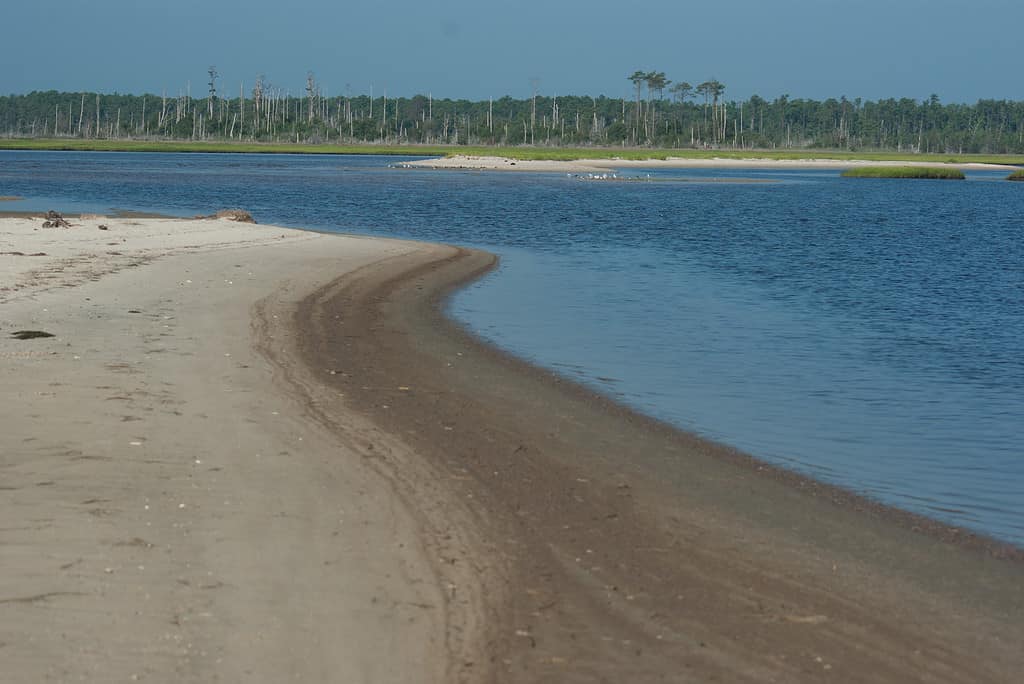
The Bethel Beach Natural Area Preserve is a 105-acre preserve consisting of sandy beaches, low dunes, and salt marshes.
©vastateparksstaff / CC BY 2.0 – License
Back Bay National Wildlife Refuge and False Cape State Park
Located on the southernmost coast of Virginia, Back Bay National Wildlife Refuge and False Cape State Park are bordered by the Atlantic Ocean on the east and the Back Bay, Sand Bay, and Shipps Bay on the west side. False Cape State Park is an awesome family location. The park offers guided kayak trips, undeveloped camping, nature programs, and 6 miles of coastline. False Cape is considered one of the most undeveloped landscapes along the U.S. Atlantic Coast.
Back Bay National Wildlife Refuge features over 9,200 acres of marsh, beaches, dunes, woodlands, and meadows. Ample parking is available in the refuge. Meanwhile, False Cape is only accessible by bikes, walking, boats, and the wildlife refuge’s tram service. The Refuge is open 30 minutes before sunrise and 30 minutes after sunset. Unless you are camping, False Cape is open from dawn until dusk.
The refuge and state park are home to over 300 species of nesting and migratory songbirds, shorebirds, and ducks. Notably, small populations of Kemp’s ridley sea turtles, loggerheads, leatherbacks, and green sea turtles nest on the shores of False Cape and Back Bay. Red foxes, white-tailed deer, river otters, raccoons, and bobcats are some of the mammals that call Back Bay Wildlife Refuge home.
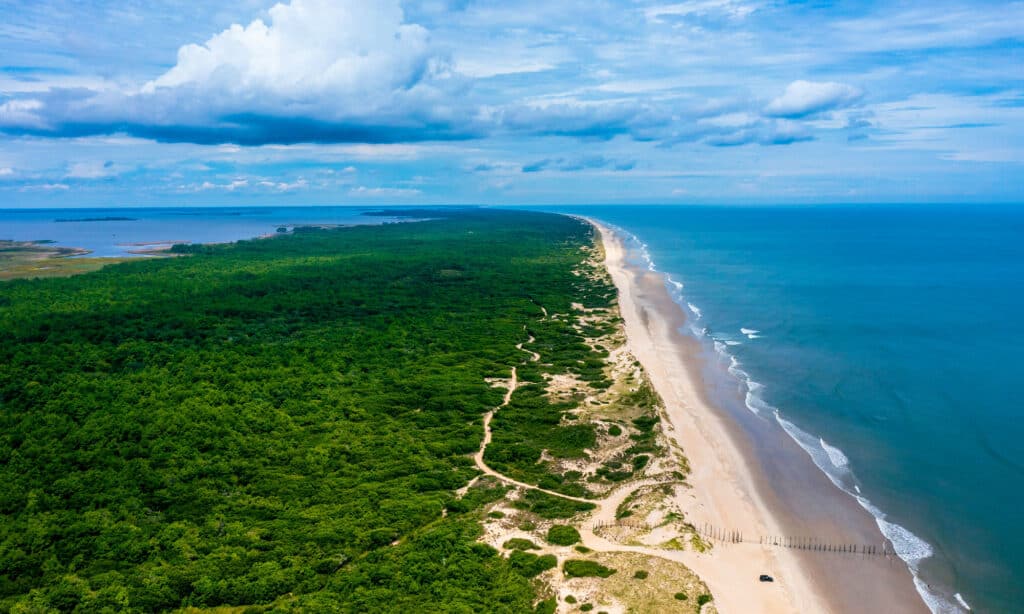
False Cape State Park is a stunning area featuring pristine beaches and wetland habitats. Here, you can camp, hike, swim, and view aquatic, avian, and terrestrial wildlife.
©Kyle J Little/Shutterstock.com
The photo featured at the top of this post is © Jon Bilous/Shutterstock.com
Thank you for reading! Have some feedback for us? Contact the AZ Animals editorial team.







